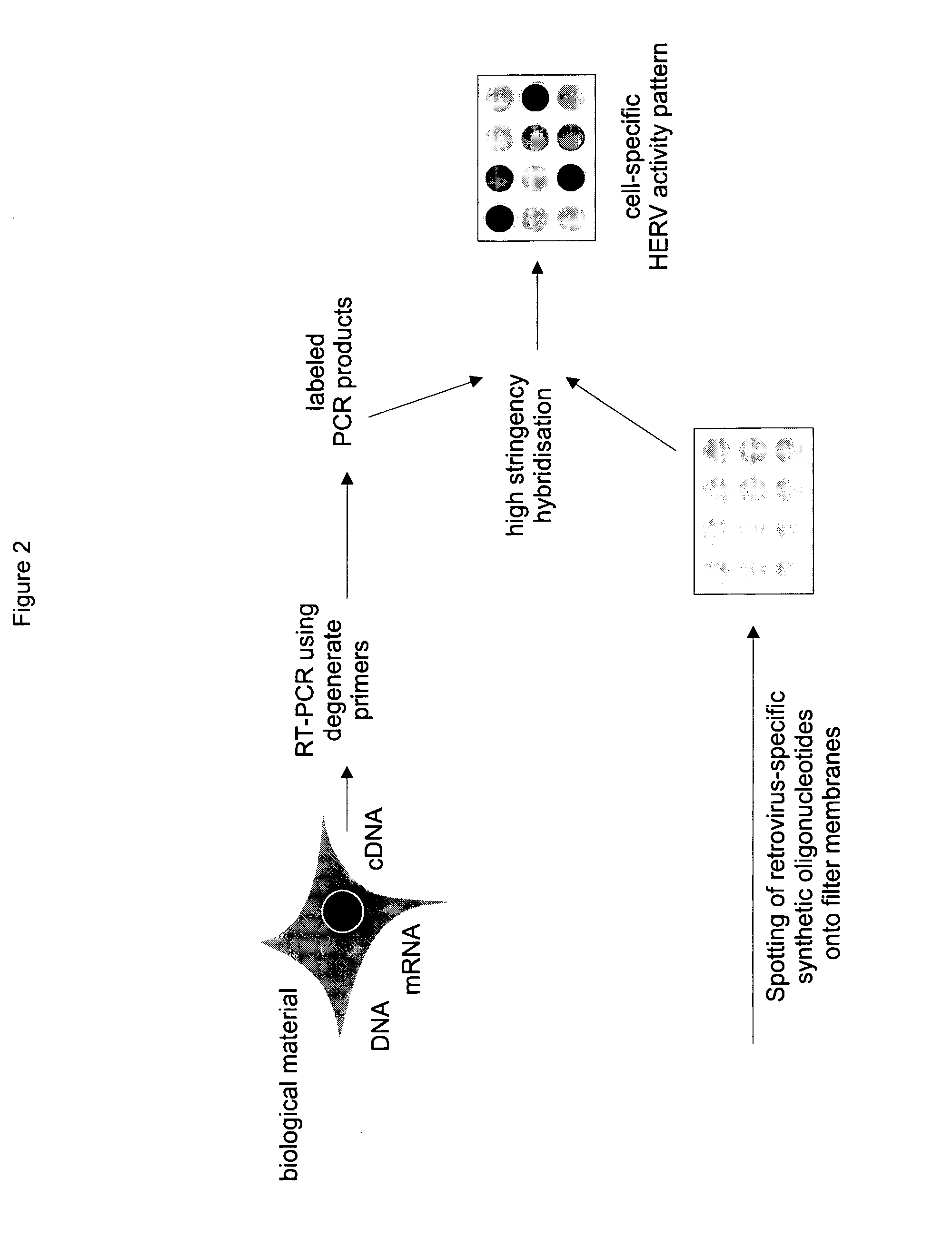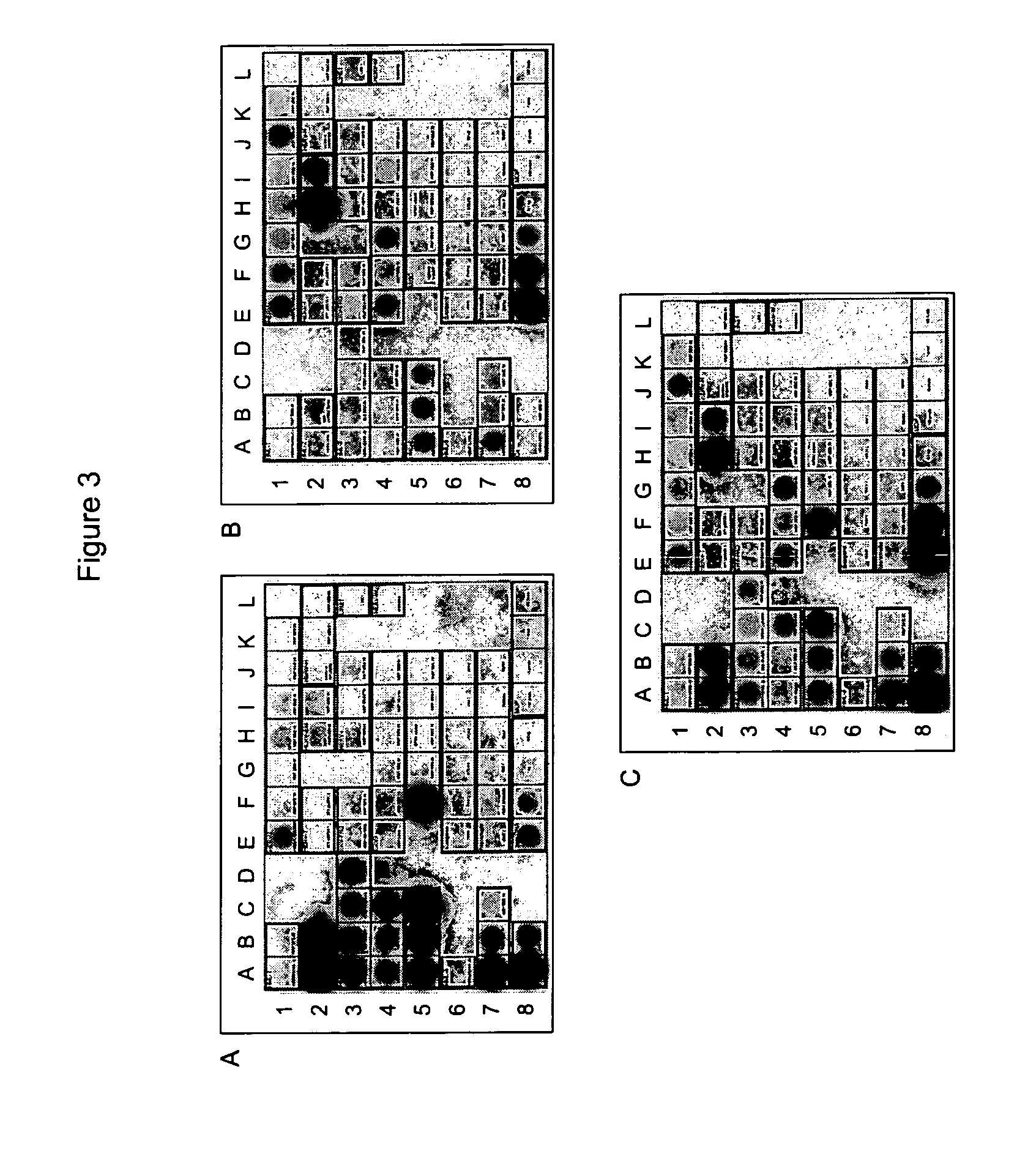Method for the specific detection and identification of retroviral nucleic acids/retroviruses in a specimen
- Summary
- Abstract
- Description
- Claims
- Application Information
AI Technical Summary
Benefits of technology
Problems solved by technology
Method used
Image
Examples
example 1
RNA Preparation
[0069]Total RNA was extracted from peripheral blood mononuclear cells of a healthy blood donor using the guanidine isothiocyanate / caesium chloride (GIT / CsCl) ultracentrifugation protocol proposed by Sambrook et al. (1989) and dissolved in distilled water treated with diethylpyrocarbonate (DEPC). The mRNA was then enriched using conventional methods e.g. using the commercially available enrichment kit ‘Dynabeads™ paramagnetic particles’ according to the manufacturer's instructions (Dynal, Hamburg, Germany). The nucleic acid concentration was determined by means of spectrometry at 260 nm. In order to check for any contamination with genomic DNA, 50 ng of each mRNA preparation was used directly, i.e., without first having undergone a reverse transcription, in a polymerase chain reaction (PCR) using the primer mixtures of degenerated oligonucleotides (MOP) according to the invention. Only those preparations which showed no DNA traces were used for the actual PCR. Those pr...
example 2
Preparation of MOP-ABD and MOP-C Primer Mixtures According to the Invention for PCR
[0070]Table 1 shows preferred MOP-ABD and MOP-C primer mixtures using the IUPAC nomenclature familiar and commonly used in specialist circles. Each of the primer mixtures contains a plurality of different forward and reverse primers. The forward primers of the MOP-ABD primer mixture exhibit the general nucleotide sequence GAAGGATCCARAGTNYTDYCHCMRGGH which comprises 3456 degenerations, i.e. 3456 different specific nucleotide sequences. The reverse primers of the MOP-ABD primer mixture exhibit the nucleotide sequence GAAGGATCCNWDDMKDTYATCMAYRWA which comprises 27648 degenerations, i.e. 27648 different specific nucleotide sequences. The forward primers of the MOP-C primer mixture are characterised by the general nucleotide sequence GAAGGATCCTKKAMMSKVYTRCYHCARGGG, which comprises 3072 degenerations, i.e. 3072 different specific nucleotide sequences and the reverse primers of the MOP-C primer mixture exhib...
example 3
Preparation of Probes for Reverse Dot Blot Hybridisation (RDBH)
[0074]Amino acid sequence comparisons have shown that the coding genes of all retrovirus for the reverse transcriptase and most retroelements exhibit highly conserved core homology regions (Poch et al. 1989, Shih et al. 1989, McClure 1993, Donehower et al. 1990, Xiong and Eickbush 1990). Two of the most conserved amino acid sequence sections are the amino acid motifs V L P Q G and Y Y / M D D I / V / L L (FIG. 1). The sequence region between these motifs comprises approximately 90 base pairs (i.e. is approximately 90 bp long) and exhibits a significantly lower homology within the various retrovirus families. This region was used to prepare retrovirus-specific probes for RDBH.
[0075]Here the following procedure was adopted: first, generally accessible nucleotide sequence data banks were searched for nucleotide sequences related to the nucleotide sequence of the reverse transcriptase (RT). Sequences of exogenous and endogenous re...
PUM
| Property | Measurement | Unit |
|---|---|---|
| Length | aaaaa | aaaaa |
| Size | aaaaa | aaaaa |
Abstract
Description
Claims
Application Information
 Login to View More
Login to View More - R&D
- Intellectual Property
- Life Sciences
- Materials
- Tech Scout
- Unparalleled Data Quality
- Higher Quality Content
- 60% Fewer Hallucinations
Browse by: Latest US Patents, China's latest patents, Technical Efficacy Thesaurus, Application Domain, Technology Topic, Popular Technical Reports.
© 2025 PatSnap. All rights reserved.Legal|Privacy policy|Modern Slavery Act Transparency Statement|Sitemap|About US| Contact US: help@patsnap.com



